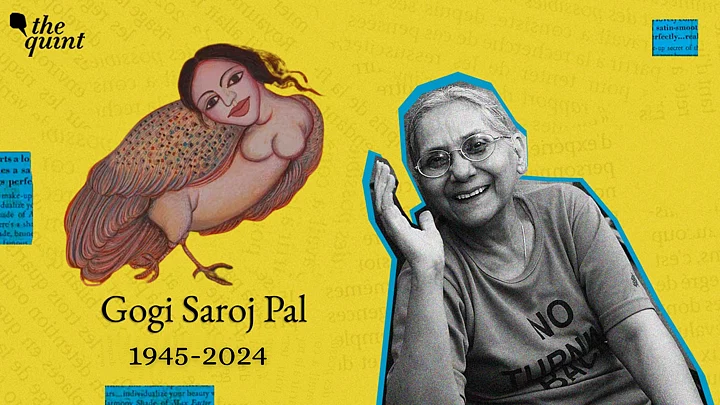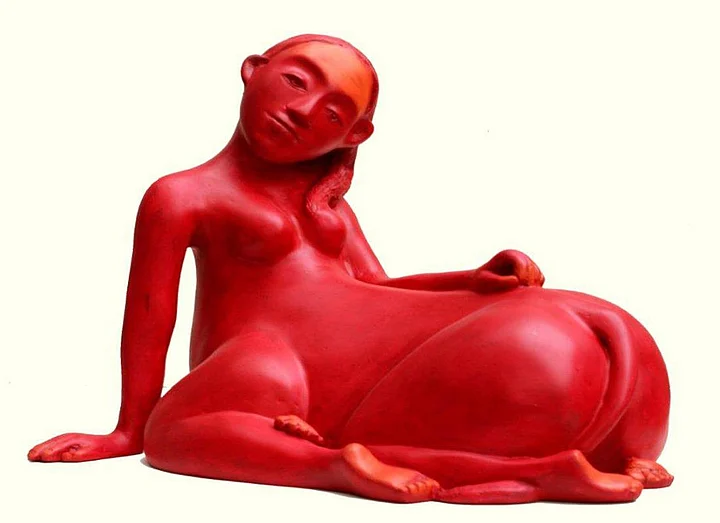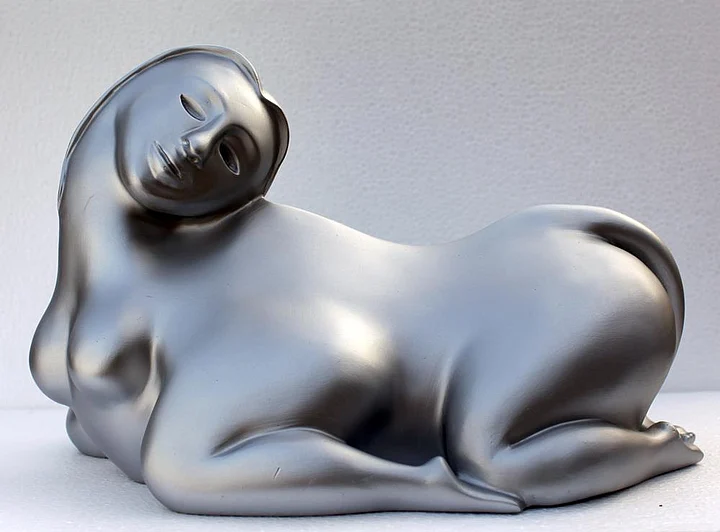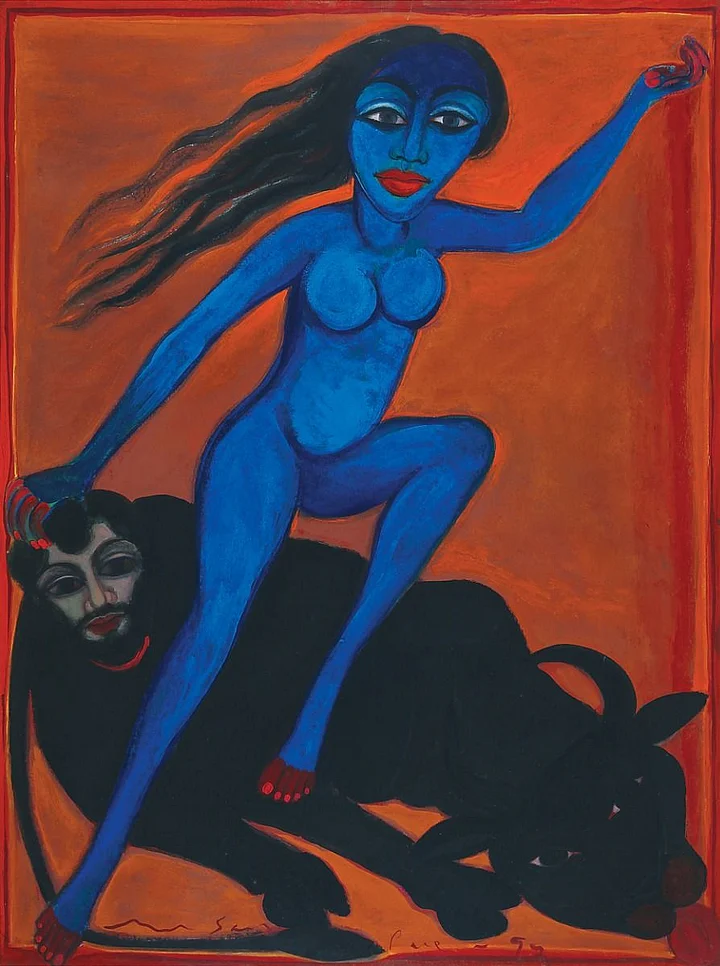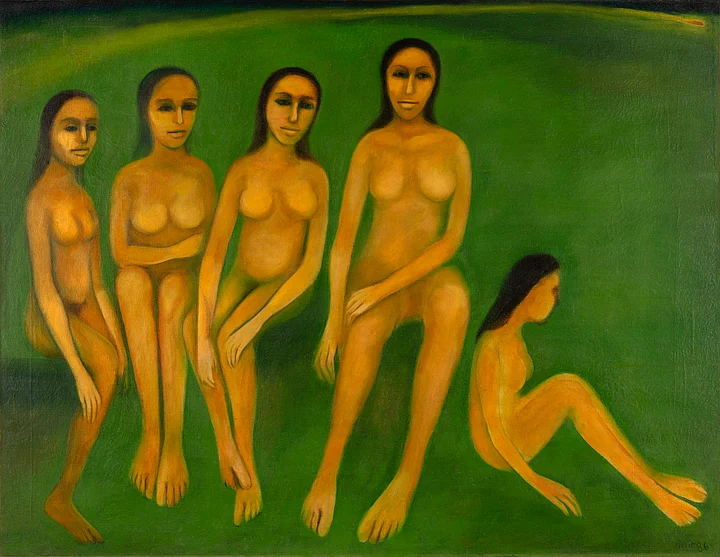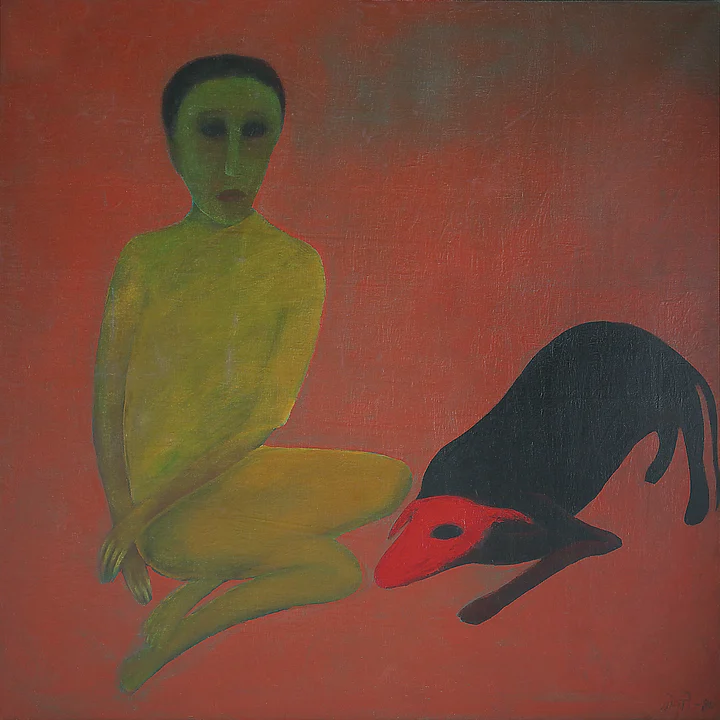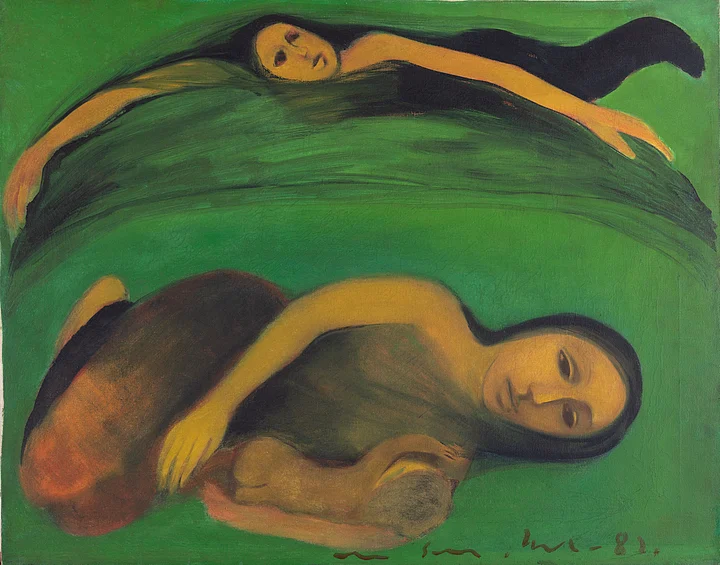Bold colours. A calm, peaceful, and miniature nayika (heroine) – a blend of tradition and modern feminism. A naked figurine, almost gazing back at her gazers with her huge eyes that sit gracefully on her long face. A silent face, yet loudly expressive of her inner desires.
This was the iconic style of 20th century contemporary artist Gogi Saroj Pal, acclaimed by many as the 'first feminist artist of India'. Renowned for reinventing Indian myths and giving them a feminist touch – and an artistic savant versed in acrylic, oil, gouache, weaving, ceramics, and lithography – Gogi passed away at her Delhi home on 27 January. She was 79.
Gogi's famous half-bird half-woman artwork is called 'Kinnari'.
'Kinnari' has wings, she desires to fly. When asked the reason behind the name, Gogi's long-time friend and Chandigarh-based veteran journalist, Nirupama Dutt shared:
"Gogi used to say that her 'Kinnari' is coined in defiance of the phrase, 'Kitni si hai tu' (How small you are), often used to undermine women. In Kangri-Punjabi, this phrase becomes 'Kinni re tu', which gives birth to 'Kinnari'. Hence, her Kinnari retaliates: 'I might be small, but when I take a flight for my desires, it shall be as long'."Nirupama Dutt, veteran journalist, and Punjabi poet, writer, and translator
From Struggle to Struggle
Gogi was born in Neoli, Uttar Pradesh, on 3 October 1945 – two years before India gained independence – into a family of freedom fighters hailing from Kangra Hills of present-day Himachal Pradesh.
Her uncle was Yashpal, the famous Indian freedom fighter and Hindi-language writer. To Gogi, defiance came naturally; it was almost genetic.
Even her childhood games had a taste of freedom. When a young Gogi would play 'stapu' or hopscotch in the verandah, her uncles would scribble "Hum amar hona chahte hain" (We wish to be immortals) with some chalk.
So, it was only natural that her art aimed at setting women free from all the societal shackles.
And defy, she did.
Her 'Kamdhenu' gave a new life to the 'wish-cow' in Indian mythology.
"People call women cows as they want her to fulfil their desires. But what about the desires of the Kamdhenu? No one talks about her," Gogi once said, talking about her sculpture.
Similarly, her painting 'Hath-yogini' was a feminist spin-off of the masculine 'Hath-yogi'; it challenged male supremacy and created a universe where women could exercise an authority similar to men.
- 01/03
'Kamdhenu' by Gogi Saroj Pal. Ceramics.
Photo: FB/GogiSarojPal

- 02/03
'Kamdhenu' by Gogi Saroj Pal. Ceramics.
Photo: FB/GogiSarojPal

- 03/03
'Hathyogini Kali' by Gogi Saroj Pal. 1997. Gouache on Japanese rice paper.
Photo: DAG Collection

- 01/03
Gogi Saroj Pal's artwork to be displayed at DAG on 3 February.
Collection: DAG

- 02/03
Gogi Saroj Pal's artwork to be displayed at DAG on 3 February.
Collection: DAG

- 03/03
Gogi Saroj Pal's artwork to be displayed at DAG on 3 February.
Collection: DAG

The nakedness in her art was also a result of her anti-colonial mindset. Nudity, once acceptable in ancient India, was looked down upon by orthodox British imperialists.
And this brazen nakedness of her nayikas, more than anything, also led to wide criticism of her work in an era when nudity was not deemed 'cool'.
It is important to note that her work was 'naked', and not 'nude'.
Prominent art critic John Berger subtly puts the difference between 'naked' and 'nude'. If art is created for the male gaze, or the pleasure of the viewer, it is a nude. But if nudity is used as a storytelling device to show the subject's vulnerability and honesty, so one is seen by others without any filters, it is naked art.
And Gogi's 'naked' nayikas were not faceless figurines. They had emotions.
So much so that Gogi's long-time friend and famous painter-sculptor Sidharth said while Gogi was "always laughing," her nayikas were sad.
"There is an eerie loneliness in the eyes of your nayikas," Sidharth recalls as once telling Gogi, "When you look at them you feel sad."
"I once asked her why her art was so sad, and Gogi remained silent for a while. She then told me about her hardships and struggles, how her openness is not tolerated by a patriarchal society. So, her nayikas impersonated her in a way – they were being held back by the society, but they still fought back."Sidharth, a famous painter and sculptor
Sidharth also shared how he and Gogi would etch lithography stones for other artists for a small fare in the 1980s:
"At that time, we used to work at Delhi's Garhi Art Studio. Although Gogi was very timid, she was very strong. Other artists there couldn't etch the heavy stones for lithography. So, Gogi and I would etch their stones for them and charge a meagre Rs 2. We would earn Rs 20-30 everyday – our bread and butter in those days."
Gogi also took her art training twice, first from the Lucknow College of Arts & Crafts, and then from Delhi College of Art. A source close to the family disclosed she wasn't happy with her Lucknow training and wanted to learn more.
One Last Flight
Gogi's hardship-ridden yet happy life took an ugly turn around 1990s.
Gogi's 18-year-old son – her only child from her first marriage – had gone to study in Bengaluru. One day, she received a call that he had met with an accident with a truck and didn't survive.
"The always-happy Gogi went silent. For a few years after the incident, she didn't interact with anyone," recalled Sidharth.
Nirupama reflected: "She would just say that 'Ghar khali ho gaya hai' (my house has become empty)."
A few years after her son's death, Gogi rediscovered her life in her art.
"I met her again almost five years after her son's death. The nayikas in her paintings became even more sorrowful, but she was laughing again," said a reminiscent Sidharth.
And Gogi found her son in the fellow young artists.
Gogi lived in Delhi's East of Kailash, with her partner, the eminent painter, Ved Nayar.
Gogi and Ved's art studio in Noida's Kala Dham and their Delhi home became a safe haven for many budding artists.
Gogi would tutor them, nurture them, and teach them art. For her, every artist, young and old, was her "bachcha" (son), and they, in turn, would call her "amma" (mother).
One of her 'bachchas' is famous Delhi-based artist, Anjum Khan, for whom Gogi's death came as a shock.
Speaking to The Quint, Anjum recalled: "I started training under her in 2013. You sometimes don't know how to go about your art. She showed me the way. I chose my subject only after having long discussions with her. She was always there to guide me. Whenever I was stuck with some work, Gogi ma'am was there to help me out. My work includes figurative artwork on women, just like hers."
Gogi also made a series of paintings in response to the 2012 Delhi gangrape case, showing 'Nirbhaya' with a sickle in her hand. The naked painting haunts the audience: Nirbhaya is not just a fierce fighter; her oppressors have forced her into picking up arms.
Most of Gogi's artworks are today a part of the art collection of New Delhi-based DAG (formerly the Delhi Art Gallery).
Ashish Anand, CEO and MD of the DAG, said: "Gogi was always delightful to work with, as irreverent in her conversation as in her art, and our relationship was peppered with her delightful observations and insightful, if candid, comments. Knowing her helped one understand her art so much better, which was a privilege I had. Her art remains behind but I will miss her personality and presence in DAG's forthcoming exhibitions of which her work will, of course, be a part."
The DAG will display several of her works in an exhibition on modern art, opening on 3 February.
Gogi is gone; but her art lives on, giving new wings to oppressed women. The eternal bird 'kinnari' has taken her one final flight.
